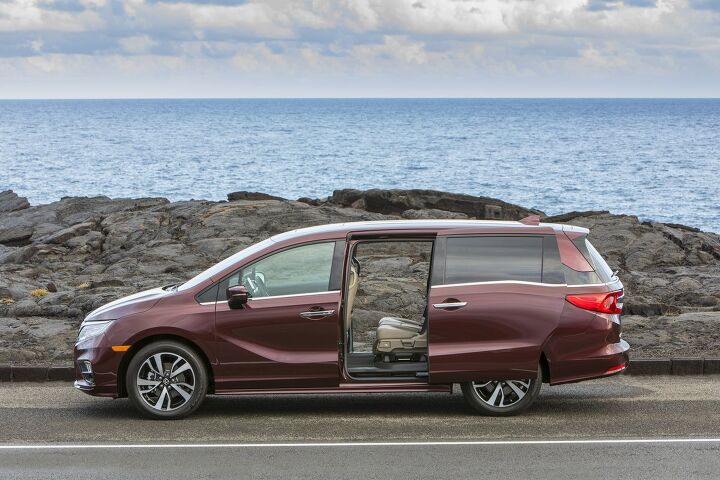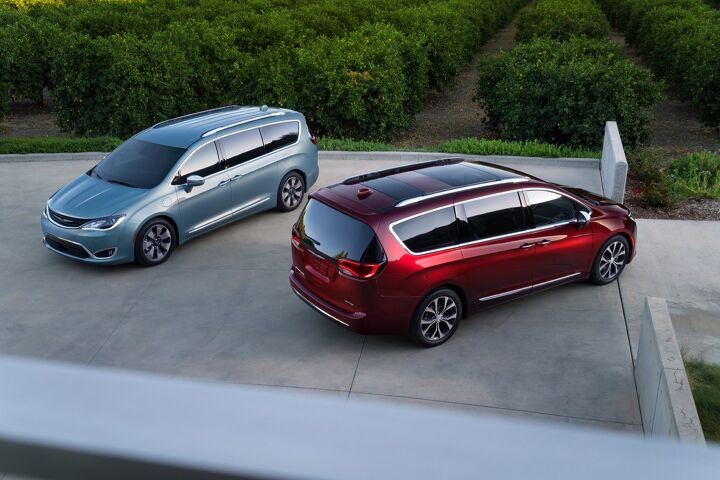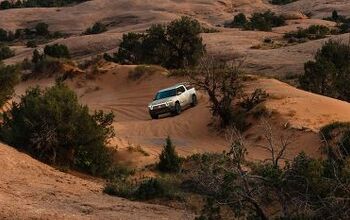After a Dreadful Start, 2017's Second Half Is the Minivan's Time To Shine - but Can the Segment Recover?
The 2018 Honda Odyssey went on sale three weeks ago. The Chrysler Pacifica has only been on the market for a year. The Toyota Sienna will enjoy another refresh for the 2018 model year.
If ever there was a time in which America’s minivan segment needs to shine, the second-half of 2017 is it.
Minivan sales tumbled 14 percent, year-over-year, through the first five months of 2017. Only 3 percent of the auto industry’s volume is now minivan-derived. Year-over-year volume decreased in nine consecutive months between August 2016 and April 2017.
There are far fewer competitors now than there were a decade ago. Therefore, the minivan market doesn’t need to produce the sort of volume it did a decade ago. However, minivan sales can’t continue to plummet, month after month after month.
Minivan sales need to rise. If they can’t do so now, then when? And if the segment can’t do it with fresh product from Chrysler, Honda, and Toyota, then who can supply the growth?
We know it’s not going to be Mazda. The mini-minivan movement is dead in America. Mazda sold 160,061 Mazda 5s in America, but that methodology is toast.
We know it’s not going to be the Nissan Quest. Nearly 80,000 fourth-generation Nissan Quests have been sold in America since 2011. But after confirming the existence of a 2017 model and then releasing that model to fleets, we now know that Nissan has killed off the Quest.
We don’t know whether the Dodge Grand Caravan can play a role in any American minivan resurgence. Through the first five months of 2017, the Grand Caravan is America’s overall minivan sales leader, claiming 30 percent of the overall market thanks to an 8-percent year-over-year sales uptick to 63,657 units. Time and time again, Fiat Chrysler Automobiles has confirmed the eventual discontinuation of the Grand Caravan. But it’s clear FCA, which never shies away from killing off models, is not at all clear on its plans for the most popular minivan in America.
Already gone are vans from Buick, Chevrolet, Ford, Mazda, Mercury, Oldsmobile, Pontiac, Saturn, and Volkswagen.
This will leave a quartet of automakers to fight over a shrinking segment; a quintet of vans (Grand Caravan still included) that will attempt to collectively make up for the lost sales from rival automakers in addition to finding new minivan owners: Chrysler Pacifica, Honda Odyssey, Kia Sedona, Toyota Sienna, and the futureless Dodge Grand Caravan.
A handful of remaining contenders are certainly primed to take advantage of the disappearance of many rivals.
Bolstered by new seating plans, improved power and efficiency, updated infotainment, and new tech features, the 2018 Honda Odyssey is also going to benefit from improved production capacity. The Odyssey’s Lincoln, Alabama, assembly plant is home to four vehicles: Odyssey, Pilot, Ridgeline, and Acura MDX. But some MDX production has moved to Ohio to free up space.
The Chrysler Pacifica, launched in the spring of 2016, is an impressive device that reached its highest sales total yet in April and then broke that record with 11,720 sales in May. The arrival of the plug-in hybrid Pacifica in early 2017 won’t soon have a significant impact on total volume, but positive press for the PHEV casts a nice glow on the Pacifica nameplate overall.
After revamping the interior for 2015 and making the Sienna America’s most powerful minivan for 2017, the 2018 Toyota Sienna is modestly facelifted and updated with more safety tech. The Sienna remains the only minivan with all-wheel-drive availability, and it’s led the segment in sales in each of the last two years.
But the weight of minivan expectations that fall on these vans is certainly hefty. Twelve years ago, Americans registered more than 1.1 million new minivans. In 2017, sales are currently on pace to fall below 480,000 units.
That pace could suddenly change. As Honda prepared the 2018 Odyssey for a May 25, 2017, dealer launch, the outgoing Odyssey reported a 30-percent decline to only 37,010 sales in the first five months of 2017. Quite a recovery is needed: Odyssey sales were stronger than that when the prior generation was finishing its run, and that was at the end of a recession.
Chrysler could witness stronger-than-expected demand for the Pacifica Hybrid. But will Pacifica Hybrid buyers come from outside the minivan category?
Toyota, which suffered an 18-percent drop in Sienna sales in the first five months of 2017, could enjoy a Sienna resurgence if some reliability-focused consumers veer away from Chrysler and a Honda in its first model year. But the third-generation Sienna is about to enter its eighth generation — it’s no fresh face.
Even Kia could benefit from a Sedona improvement if other vans shine a positive light on the market, though the Sedona has had an opportunity to grab the advantage in early 2017 and sales instead fell 29 percent.
Presumably, given its status as The Establishment and its value-oriented price point, the Dodge Grand Caravan could continue to grow its sales throughout 2017. Whether that growth represents any long-lasting interest in the minivan sector as a whole, however, is another matter.
More likely than not, some of the positive possibilities — though not all — will come to fruition. Likewise, some, though not all, of the negative possibilities will come to pass, as well.
Ideally, America’s minivan segment will show healthy signs of improvement, built up by new product. If not, expect to see minivan choice continue to be cut back. You may be a minivan lover, you may be a minivan hater. But we should all be fans of automotive choice.
[Images: Honda; Fiat Chrysler Automobiles]
Timothy Cain is a contributing analyst at The Truth About Cars and Autofocus.ca and the founder and former editor of GoodCarBadCar.net. Follow on Twitter @timcaincars.
More by Timothy Cain
Latest Car Reviews
Read moreLatest Product Reviews
Read moreRecent Comments
- Formula m How many Hyundai and Kia’s do not have the original engine block it left the factory with 10yrs prior?
- 1995 SC I will say that year 29 has been a little spendy on my car (Motor Mounts, Injectors and a Supercharger Service since it had to come off for the injectors, ABS Pump and the tool to cycle the valves to bleed the system, Front Calipers, rear pinion seal, transmission service with a new pan that has a drain, a gaggle of capacitors to fix the ride control module and a replacement amplifier for the stereo. Still needs an exhaust manifold gasket. The front end got serviced in year 28. On the plus side blank cassettes are increasingly easy to find so I have a solid collection of 90 minute playlists.
- MaintenanceCosts My own experiences with, well, maintenance costs:Chevy Bolt, ownership from new to 4.5 years, ~$400*Toyota Highlander Hybrid, ownership from 3.5 to 8 years, ~$2400BMW 335i Convertible, ownership from 11.5 to 13 years, ~$1200Acura Legend, ownership from 20 to 29 years, ~$11,500***Includes a new 12V battery and a set of wiper blades. In fairness, bigger bills for coolant and tire replacement are coming in year 5.**Includes replacement of all rubber parts, rebuild of entire suspension and steering system, and conversion of car to OEM 16" wheel set, among other things
- Jeff Tesla should not be allowed to call its system Full Self-Driving. Very dangerous and misleading.
- Slavuta America, the evil totalitarian police state




































Comments
Join the conversation
"And if the segment can’t do it with fresh product from Chrysler, Honda, and Toyota, then who can supply the growth?" I surprisingly liked the new Sedona. Its pretty price competitive at the lower trims. I think it mostly has a marketing problem.
The minivan is a practical car. It's sold on its utilitarian value. The practical car buyer today has many choices, most of them lightly-used. The practical car buyer will try to avoid a hefty car note. Today's buyers are IMpractical - they're the ones buying image or fantasy. That's why $80,000 diesel bro-dozers are screaming off the lots. That's why four-wheel drive is so desired in areas that see little snow; to people who are more likely to die than to camp out. The chaotic, uncertain economy is a problem for those who would have families - and the products those families might want.